Leadership and Management Strategies in Healthcare Organizations
VerifiedAdded on 2023/06/15
|14
|3407
|423
Report
AI Summary
This report analyses key aspects of leadership and management within healthcare organizations, emphasizing the importance of situational leadership and management by objectives (MBO). It contrasts the roles of leaders and managers, highlighting that situational leaders play a more critical role in healthcare settings. The report discusses principles for fostering an effective working environment, including meaningful dialogue, appreciation, and employee trust. It also examines the role of healthcare organizations in developing effective managers and leaders, focusing on communication, resource improvement, and quality enhancement. The analysis underscores the necessity of aligning individual roles with common goals to achieve consistent leadership and improve patient care, with the report available on Desklib for further study.
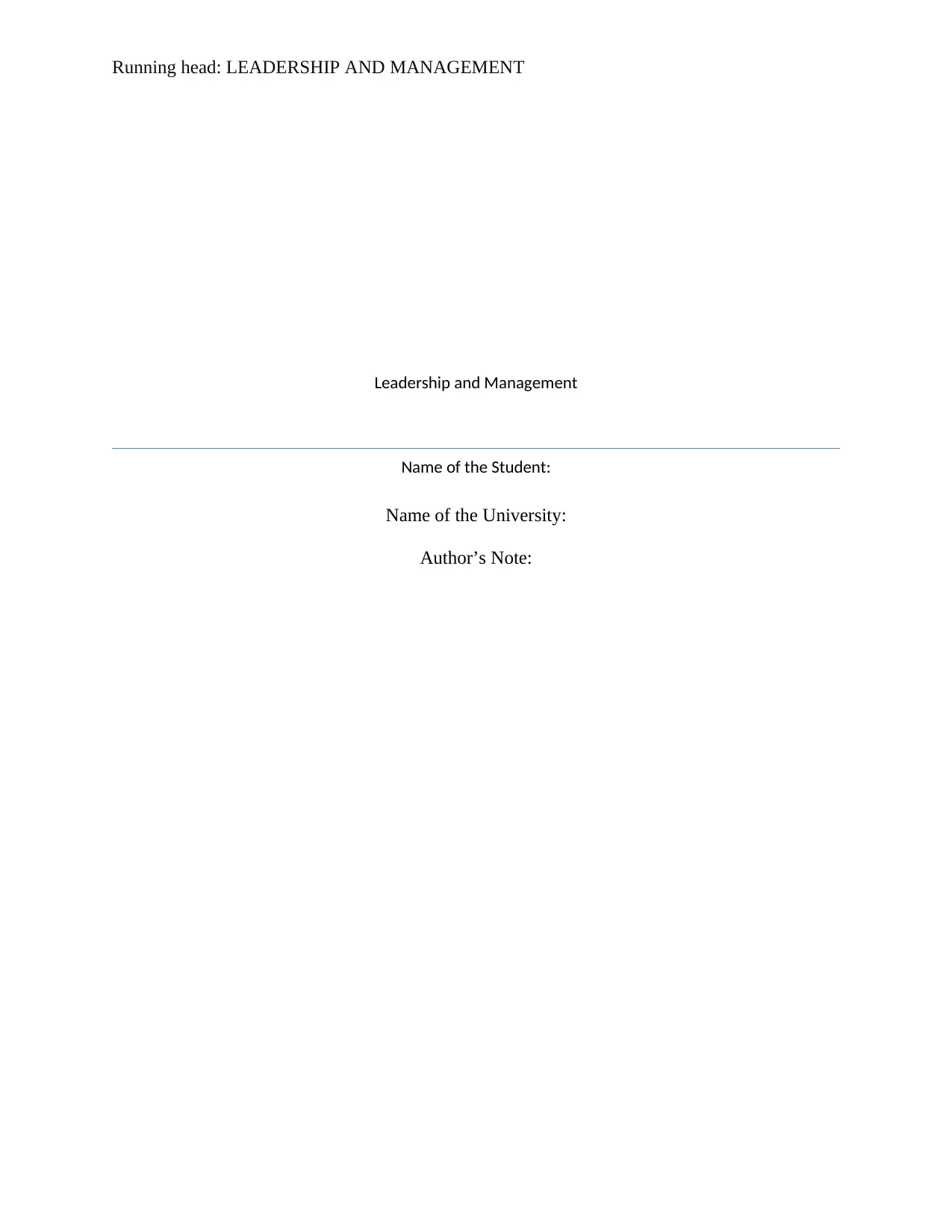
Running head: LEADERSHIP AND MANAGEMENT
Leadership and Management
Name of the Student:
Name of the University:
Author’s Note:
Leadership and Management
Name of the Student:
Name of the University:
Author’s Note:
Paraphrase This Document
Need a fresh take? Get an instant paraphrase of this document with our AI Paraphraser
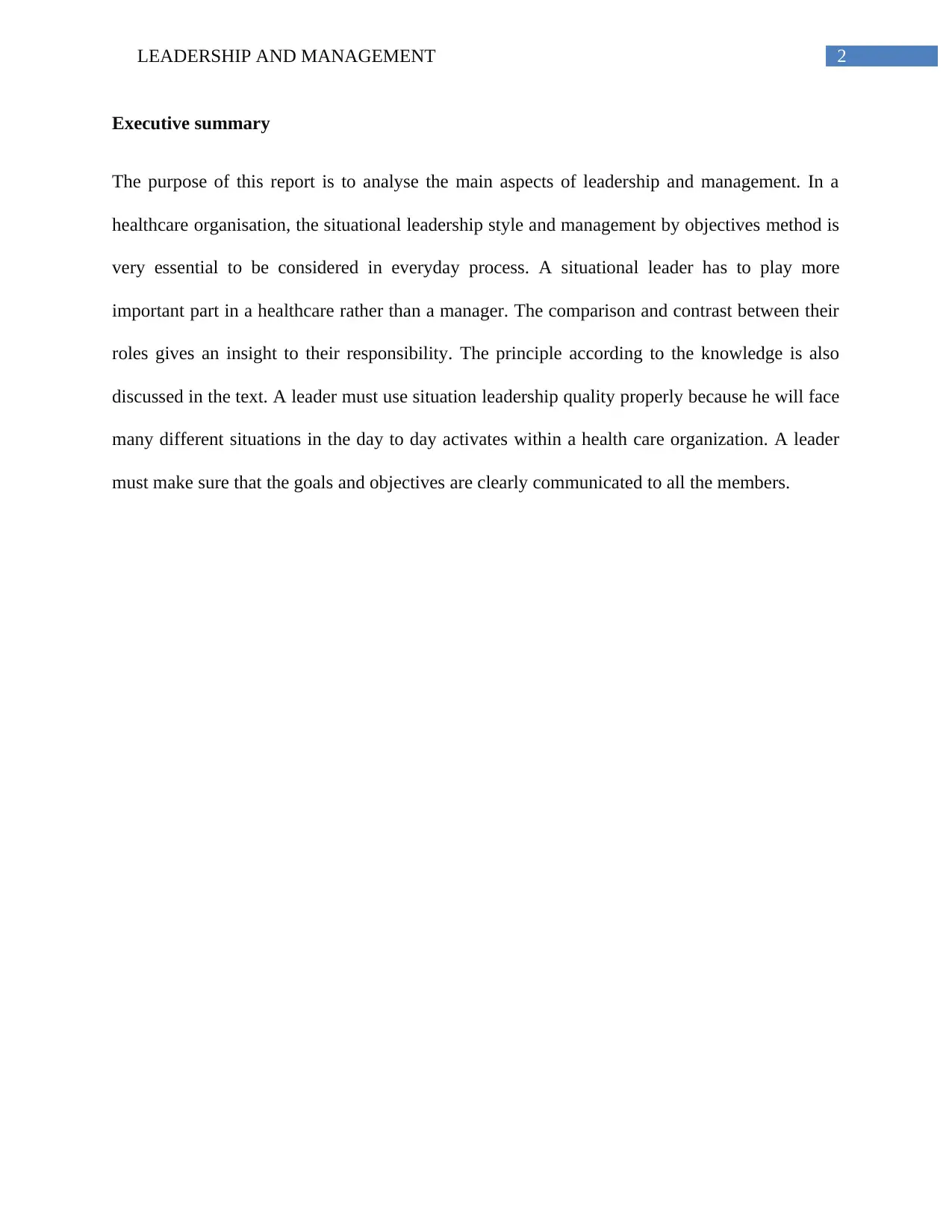
2LEADERSHIP AND MANAGEMENT
Executive summary
The purpose of this report is to analyse the main aspects of leadership and management. In a
healthcare organisation, the situational leadership style and management by objectives method is
very essential to be considered in everyday process. A situational leader has to play more
important part in a healthcare rather than a manager. The comparison and contrast between their
roles gives an insight to their responsibility. The principle according to the knowledge is also
discussed in the text. A leader must use situation leadership quality properly because he will face
many different situations in the day to day activates within a health care organization. A leader
must make sure that the goals and objectives are clearly communicated to all the members.
Executive summary
The purpose of this report is to analyse the main aspects of leadership and management. In a
healthcare organisation, the situational leadership style and management by objectives method is
very essential to be considered in everyday process. A situational leader has to play more
important part in a healthcare rather than a manager. The comparison and contrast between their
roles gives an insight to their responsibility. The principle according to the knowledge is also
discussed in the text. A leader must use situation leadership quality properly because he will face
many different situations in the day to day activates within a health care organization. A leader
must make sure that the goals and objectives are clearly communicated to all the members.
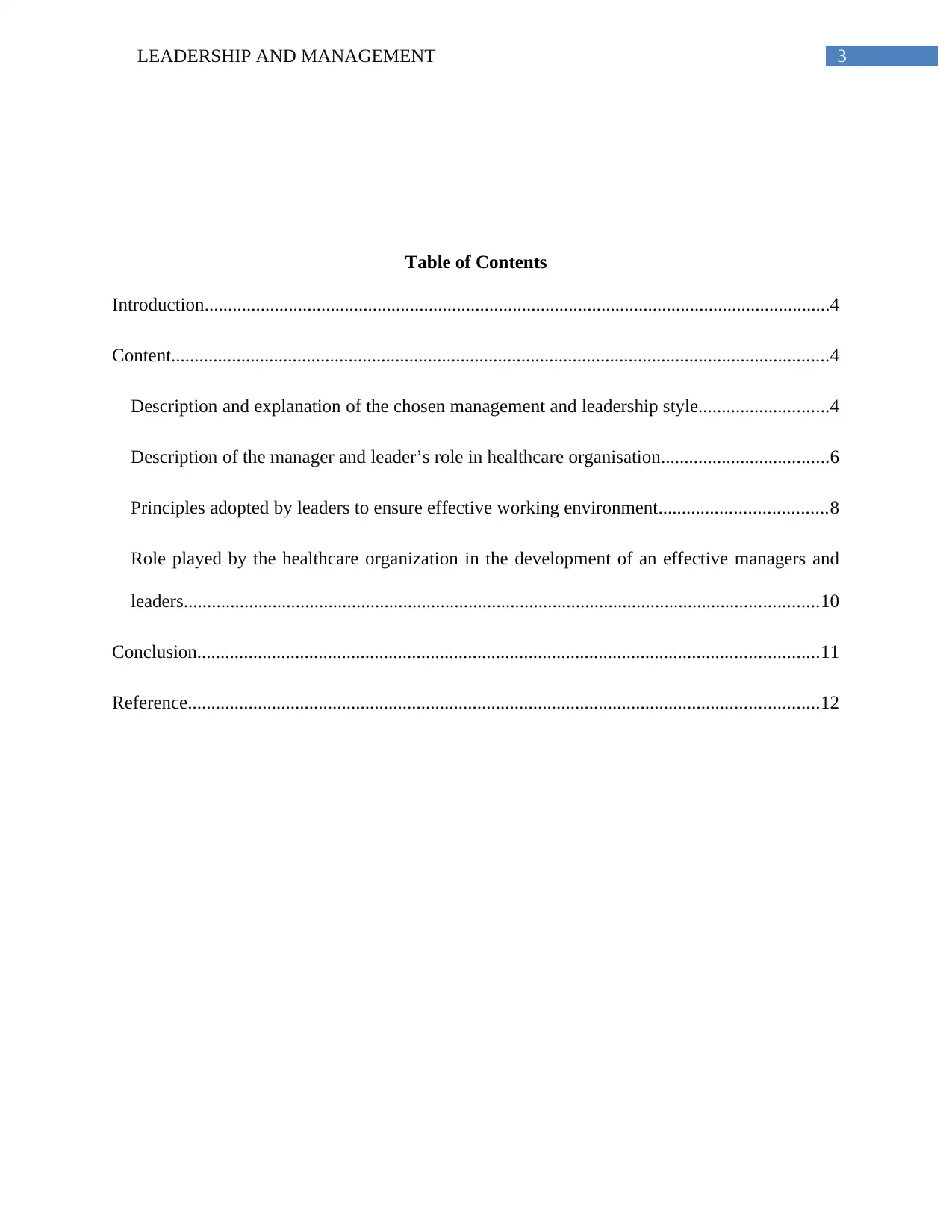
3LEADERSHIP AND MANAGEMENT
Table of Contents
Introduction......................................................................................................................................4
Content.............................................................................................................................................4
Description and explanation of the chosen management and leadership style............................4
Description of the manager and leader’s role in healthcare organisation....................................6
Principles adopted by leaders to ensure effective working environment....................................8
Role played by the healthcare organization in the development of an effective managers and
leaders........................................................................................................................................10
Conclusion.....................................................................................................................................11
Reference.......................................................................................................................................12
Table of Contents
Introduction......................................................................................................................................4
Content.............................................................................................................................................4
Description and explanation of the chosen management and leadership style............................4
Description of the manager and leader’s role in healthcare organisation....................................6
Principles adopted by leaders to ensure effective working environment....................................8
Role played by the healthcare organization in the development of an effective managers and
leaders........................................................................................................................................10
Conclusion.....................................................................................................................................11
Reference.......................................................................................................................................12
⊘ This is a preview!⊘
Do you want full access?
Subscribe today to unlock all pages.

Trusted by 1+ million students worldwide
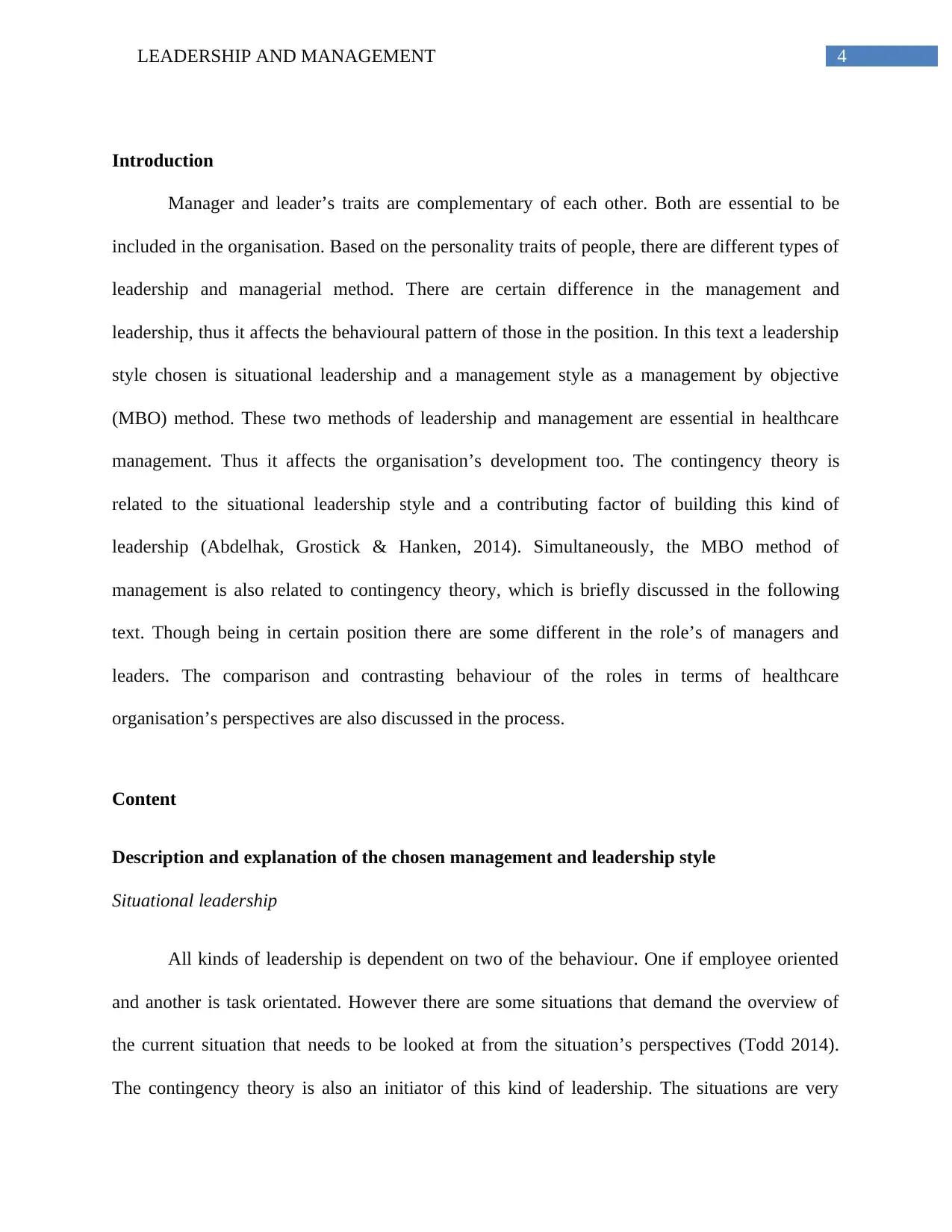
4LEADERSHIP AND MANAGEMENT
Introduction
Manager and leader’s traits are complementary of each other. Both are essential to be
included in the organisation. Based on the personality traits of people, there are different types of
leadership and managerial method. There are certain difference in the management and
leadership, thus it affects the behavioural pattern of those in the position. In this text a leadership
style chosen is situational leadership and a management style as a management by objective
(MBO) method. These two methods of leadership and management are essential in healthcare
management. Thus it affects the organisation’s development too. The contingency theory is
related to the situational leadership style and a contributing factor of building this kind of
leadership (Abdelhak, Grostick & Hanken, 2014). Simultaneously, the MBO method of
management is also related to contingency theory, which is briefly discussed in the following
text. Though being in certain position there are some different in the role’s of managers and
leaders. The comparison and contrasting behaviour of the roles in terms of healthcare
organisation’s perspectives are also discussed in the process.
Content
Description and explanation of the chosen management and leadership style
Situational leadership
All kinds of leadership is dependent on two of the behaviour. One if employee oriented
and another is task orientated. However there are some situations that demand the overview of
the current situation that needs to be looked at from the situation’s perspectives (Todd 2014).
The contingency theory is also an initiator of this kind of leadership. The situations are very
Introduction
Manager and leader’s traits are complementary of each other. Both are essential to be
included in the organisation. Based on the personality traits of people, there are different types of
leadership and managerial method. There are certain difference in the management and
leadership, thus it affects the behavioural pattern of those in the position. In this text a leadership
style chosen is situational leadership and a management style as a management by objective
(MBO) method. These two methods of leadership and management are essential in healthcare
management. Thus it affects the organisation’s development too. The contingency theory is
related to the situational leadership style and a contributing factor of building this kind of
leadership (Abdelhak, Grostick & Hanken, 2014). Simultaneously, the MBO method of
management is also related to contingency theory, which is briefly discussed in the following
text. Though being in certain position there are some different in the role’s of managers and
leaders. The comparison and contrasting behaviour of the roles in terms of healthcare
organisation’s perspectives are also discussed in the process.
Content
Description and explanation of the chosen management and leadership style
Situational leadership
All kinds of leadership is dependent on two of the behaviour. One if employee oriented
and another is task orientated. However there are some situations that demand the overview of
the current situation that needs to be looked at from the situation’s perspectives (Todd 2014).
The contingency theory is also an initiator of this kind of leadership. The situations are very
Paraphrase This Document
Need a fresh take? Get an instant paraphrase of this document with our AI Paraphraser
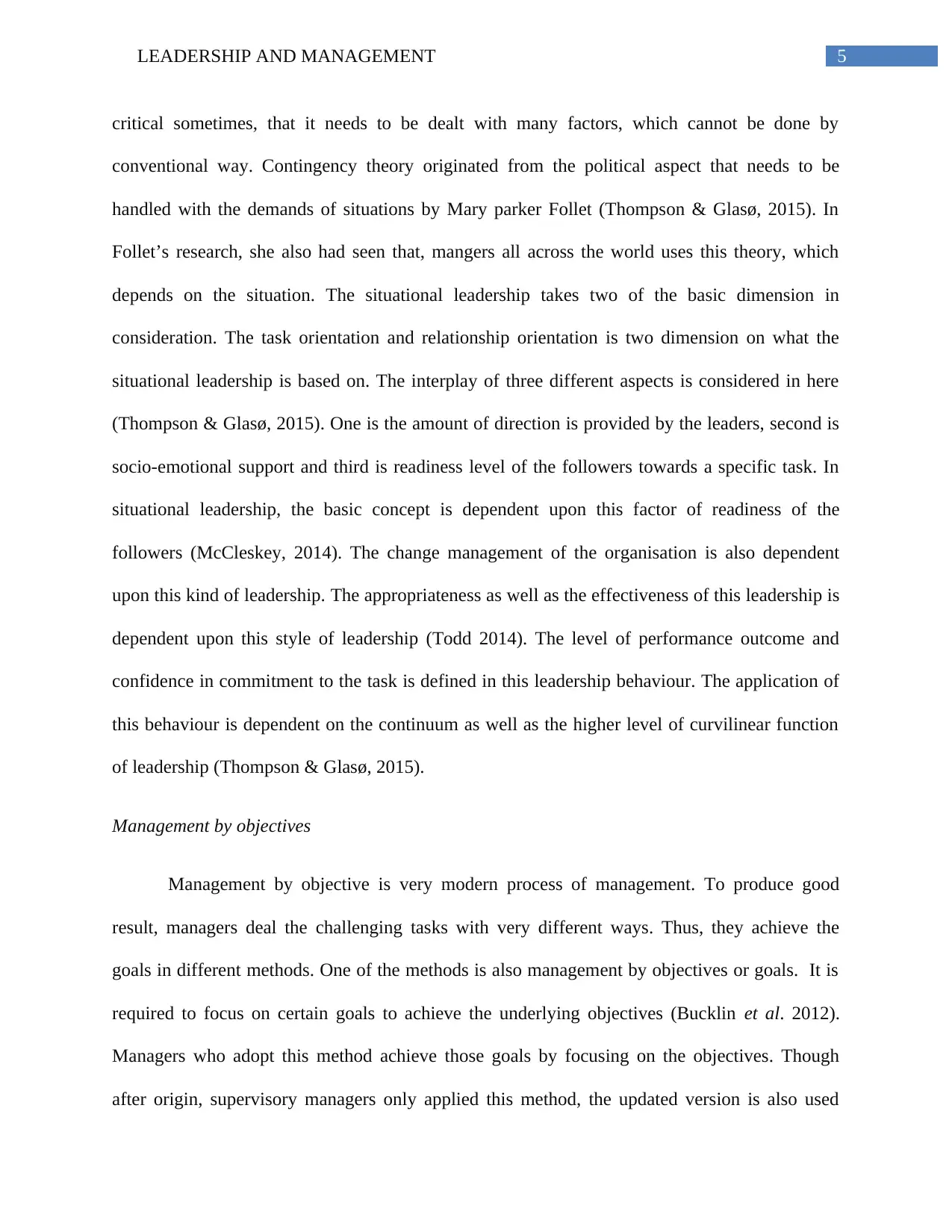
5LEADERSHIP AND MANAGEMENT
critical sometimes, that it needs to be dealt with many factors, which cannot be done by
conventional way. Contingency theory originated from the political aspect that needs to be
handled with the demands of situations by Mary parker Follet (Thompson & Glasø, 2015). In
Follet’s research, she also had seen that, mangers all across the world uses this theory, which
depends on the situation. The situational leadership takes two of the basic dimension in
consideration. The task orientation and relationship orientation is two dimension on what the
situational leadership is based on. The interplay of three different aspects is considered in here
(Thompson & Glasø, 2015). One is the amount of direction is provided by the leaders, second is
socio-emotional support and third is readiness level of the followers towards a specific task. In
situational leadership, the basic concept is dependent upon this factor of readiness of the
followers (McCleskey, 2014). The change management of the organisation is also dependent
upon this kind of leadership. The appropriateness as well as the effectiveness of this leadership is
dependent upon this style of leadership (Todd 2014). The level of performance outcome and
confidence in commitment to the task is defined in this leadership behaviour. The application of
this behaviour is dependent on the continuum as well as the higher level of curvilinear function
of leadership (Thompson & Glasø, 2015).
Management by objectives
Management by objective is very modern process of management. To produce good
result, managers deal the challenging tasks with very different ways. Thus, they achieve the
goals in different methods. One of the methods is also management by objectives or goals. It is
required to focus on certain goals to achieve the underlying objectives (Bucklin et al. 2012).
Managers who adopt this method achieve those goals by focusing on the objectives. Though
after origin, supervisory managers only applied this method, the updated version is also used
critical sometimes, that it needs to be dealt with many factors, which cannot be done by
conventional way. Contingency theory originated from the political aspect that needs to be
handled with the demands of situations by Mary parker Follet (Thompson & Glasø, 2015). In
Follet’s research, she also had seen that, mangers all across the world uses this theory, which
depends on the situation. The situational leadership takes two of the basic dimension in
consideration. The task orientation and relationship orientation is two dimension on what the
situational leadership is based on. The interplay of three different aspects is considered in here
(Thompson & Glasø, 2015). One is the amount of direction is provided by the leaders, second is
socio-emotional support and third is readiness level of the followers towards a specific task. In
situational leadership, the basic concept is dependent upon this factor of readiness of the
followers (McCleskey, 2014). The change management of the organisation is also dependent
upon this kind of leadership. The appropriateness as well as the effectiveness of this leadership is
dependent upon this style of leadership (Todd 2014). The level of performance outcome and
confidence in commitment to the task is defined in this leadership behaviour. The application of
this behaviour is dependent on the continuum as well as the higher level of curvilinear function
of leadership (Thompson & Glasø, 2015).
Management by objectives
Management by objective is very modern process of management. To produce good
result, managers deal the challenging tasks with very different ways. Thus, they achieve the
goals in different methods. One of the methods is also management by objectives or goals. It is
required to focus on certain goals to achieve the underlying objectives (Bucklin et al. 2012).
Managers who adopt this method achieve those goals by focusing on the objectives. Though
after origin, supervisory managers only applied this method, the updated version is also used
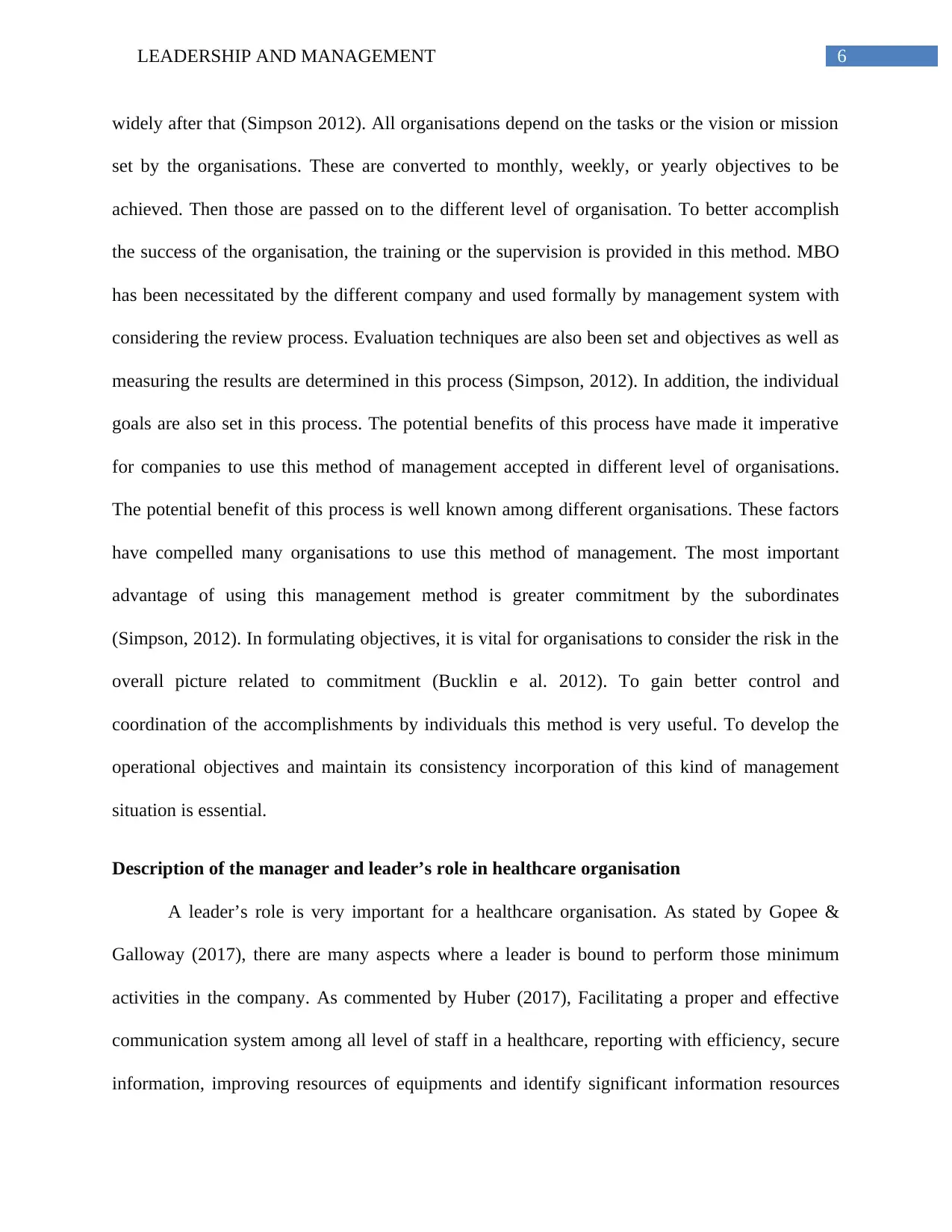
6LEADERSHIP AND MANAGEMENT
widely after that (Simpson 2012). All organisations depend on the tasks or the vision or mission
set by the organisations. These are converted to monthly, weekly, or yearly objectives to be
achieved. Then those are passed on to the different level of organisation. To better accomplish
the success of the organisation, the training or the supervision is provided in this method. MBO
has been necessitated by the different company and used formally by management system with
considering the review process. Evaluation techniques are also been set and objectives as well as
measuring the results are determined in this process (Simpson, 2012). In addition, the individual
goals are also set in this process. The potential benefits of this process have made it imperative
for companies to use this method of management accepted in different level of organisations.
The potential benefit of this process is well known among different organisations. These factors
have compelled many organisations to use this method of management. The most important
advantage of using this management method is greater commitment by the subordinates
(Simpson, 2012). In formulating objectives, it is vital for organisations to consider the risk in the
overall picture related to commitment (Bucklin e al. 2012). To gain better control and
coordination of the accomplishments by individuals this method is very useful. To develop the
operational objectives and maintain its consistency incorporation of this kind of management
situation is essential.
Description of the manager and leader’s role in healthcare organisation
A leader’s role is very important for a healthcare organisation. As stated by Gopee &
Galloway (2017), there are many aspects where a leader is bound to perform those minimum
activities in the company. As commented by Huber (2017), Facilitating a proper and effective
communication system among all level of staff in a healthcare, reporting with efficiency, secure
information, improving resources of equipments and identify significant information resources
widely after that (Simpson 2012). All organisations depend on the tasks or the vision or mission
set by the organisations. These are converted to monthly, weekly, or yearly objectives to be
achieved. Then those are passed on to the different level of organisation. To better accomplish
the success of the organisation, the training or the supervision is provided in this method. MBO
has been necessitated by the different company and used formally by management system with
considering the review process. Evaluation techniques are also been set and objectives as well as
measuring the results are determined in this process (Simpson, 2012). In addition, the individual
goals are also set in this process. The potential benefits of this process have made it imperative
for companies to use this method of management accepted in different level of organisations.
The potential benefit of this process is well known among different organisations. These factors
have compelled many organisations to use this method of management. The most important
advantage of using this management method is greater commitment by the subordinates
(Simpson, 2012). In formulating objectives, it is vital for organisations to consider the risk in the
overall picture related to commitment (Bucklin e al. 2012). To gain better control and
coordination of the accomplishments by individuals this method is very useful. To develop the
operational objectives and maintain its consistency incorporation of this kind of management
situation is essential.
Description of the manager and leader’s role in healthcare organisation
A leader’s role is very important for a healthcare organisation. As stated by Gopee &
Galloway (2017), there are many aspects where a leader is bound to perform those minimum
activities in the company. As commented by Huber (2017), Facilitating a proper and effective
communication system among all level of staff in a healthcare, reporting with efficiency, secure
information, improving resources of equipments and identify significant information resources
⊘ This is a preview!⊘
Do you want full access?
Subscribe today to unlock all pages.

Trusted by 1+ million students worldwide
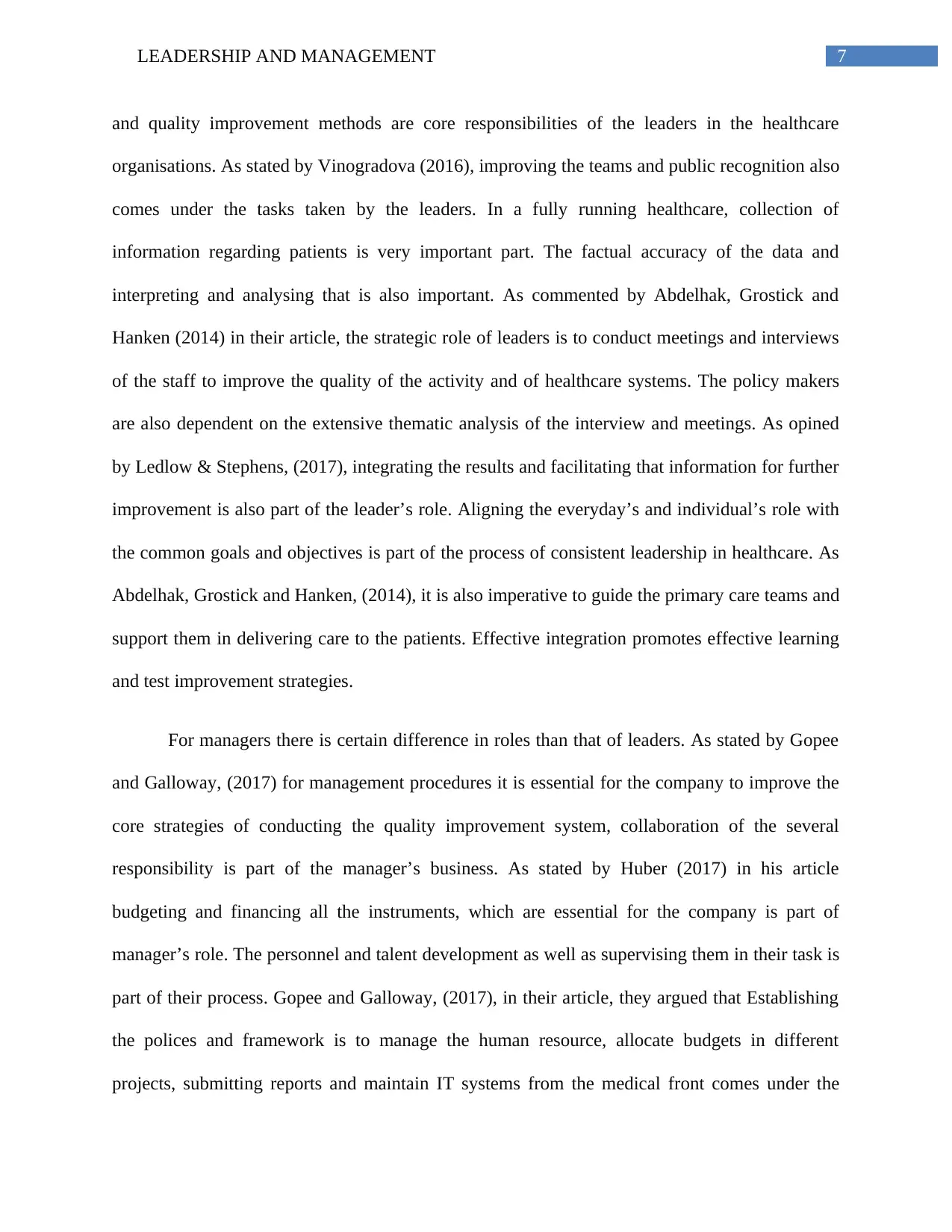
7LEADERSHIP AND MANAGEMENT
and quality improvement methods are core responsibilities of the leaders in the healthcare
organisations. As stated by Vinogradova (2016), improving the teams and public recognition also
comes under the tasks taken by the leaders. In a fully running healthcare, collection of
information regarding patients is very important part. The factual accuracy of the data and
interpreting and analysing that is also important. As commented by Abdelhak, Grostick and
Hanken (2014) in their article, the strategic role of leaders is to conduct meetings and interviews
of the staff to improve the quality of the activity and of healthcare systems. The policy makers
are also dependent on the extensive thematic analysis of the interview and meetings. As opined
by Ledlow & Stephens, (2017), integrating the results and facilitating that information for further
improvement is also part of the leader’s role. Aligning the everyday’s and individual’s role with
the common goals and objectives is part of the process of consistent leadership in healthcare. As
Abdelhak, Grostick and Hanken, (2014), it is also imperative to guide the primary care teams and
support them in delivering care to the patients. Effective integration promotes effective learning
and test improvement strategies.
For managers there is certain difference in roles than that of leaders. As stated by Gopee
and Galloway, (2017) for management procedures it is essential for the company to improve the
core strategies of conducting the quality improvement system, collaboration of the several
responsibility is part of the manager’s business. As stated by Huber (2017) in his article
budgeting and financing all the instruments, which are essential for the company is part of
manager’s role. The personnel and talent development as well as supervising them in their task is
part of their process. Gopee and Galloway, (2017), in their article, they argued that Establishing
the polices and framework is to manage the human resource, allocate budgets in different
projects, submitting reports and maintain IT systems from the medical front comes under the
and quality improvement methods are core responsibilities of the leaders in the healthcare
organisations. As stated by Vinogradova (2016), improving the teams and public recognition also
comes under the tasks taken by the leaders. In a fully running healthcare, collection of
information regarding patients is very important part. The factual accuracy of the data and
interpreting and analysing that is also important. As commented by Abdelhak, Grostick and
Hanken (2014) in their article, the strategic role of leaders is to conduct meetings and interviews
of the staff to improve the quality of the activity and of healthcare systems. The policy makers
are also dependent on the extensive thematic analysis of the interview and meetings. As opined
by Ledlow & Stephens, (2017), integrating the results and facilitating that information for further
improvement is also part of the leader’s role. Aligning the everyday’s and individual’s role with
the common goals and objectives is part of the process of consistent leadership in healthcare. As
Abdelhak, Grostick and Hanken, (2014), it is also imperative to guide the primary care teams and
support them in delivering care to the patients. Effective integration promotes effective learning
and test improvement strategies.
For managers there is certain difference in roles than that of leaders. As stated by Gopee
and Galloway, (2017) for management procedures it is essential for the company to improve the
core strategies of conducting the quality improvement system, collaboration of the several
responsibility is part of the manager’s business. As stated by Huber (2017) in his article
budgeting and financing all the instruments, which are essential for the company is part of
manager’s role. The personnel and talent development as well as supervising them in their task is
part of their process. Gopee and Galloway, (2017), in their article, they argued that Establishing
the polices and framework is to manage the human resource, allocate budgets in different
projects, submitting reports and maintain IT systems from the medical front comes under the
Paraphrase This Document
Need a fresh take? Get an instant paraphrase of this document with our AI Paraphraser
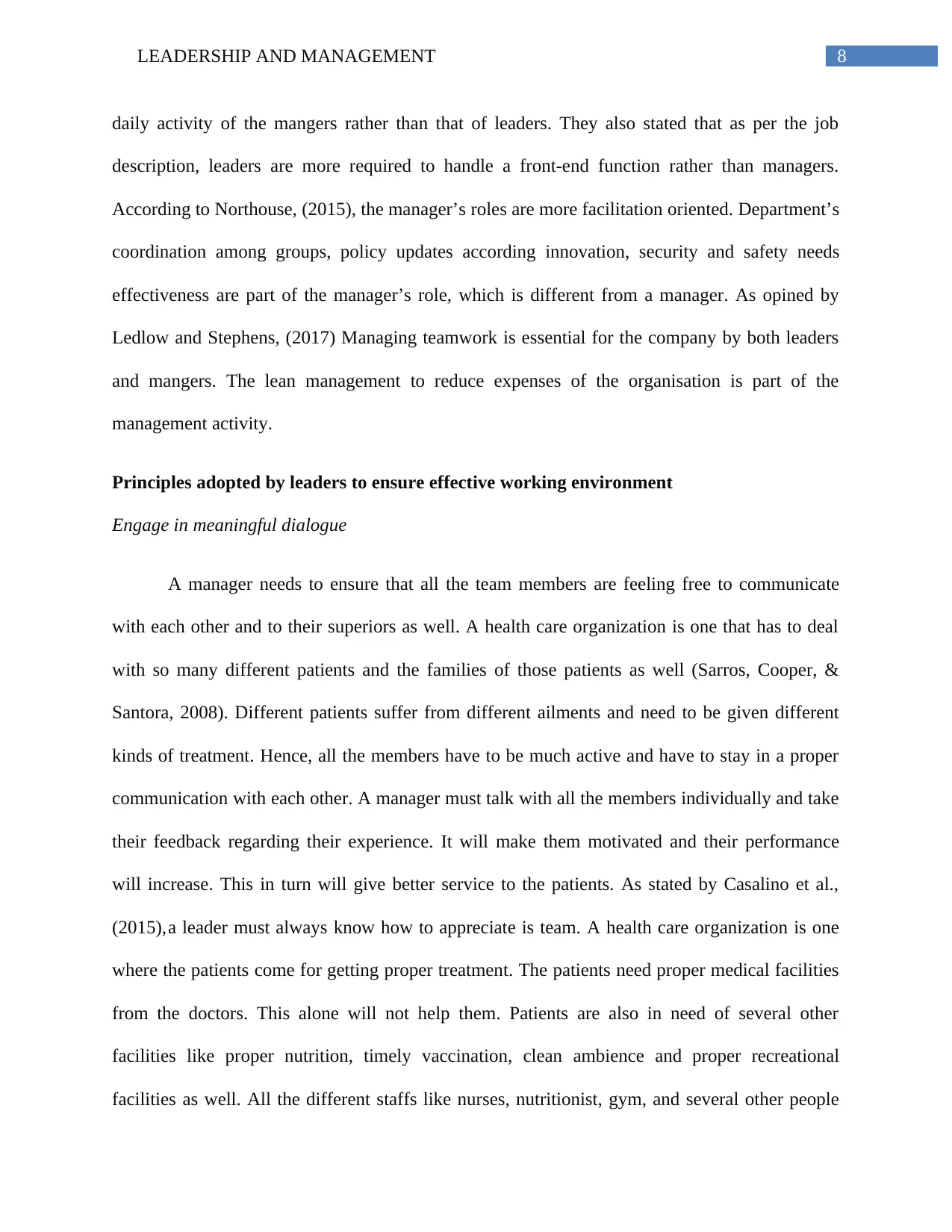
8LEADERSHIP AND MANAGEMENT
daily activity of the mangers rather than that of leaders. They also stated that as per the job
description, leaders are more required to handle a front-end function rather than managers.
According to Northouse, (2015), the manager’s roles are more facilitation oriented. Department’s
coordination among groups, policy updates according innovation, security and safety needs
effectiveness are part of the manager’s role, which is different from a manager. As opined by
Ledlow and Stephens, (2017) Managing teamwork is essential for the company by both leaders
and mangers. The lean management to reduce expenses of the organisation is part of the
management activity.
Principles adopted by leaders to ensure effective working environment
Engage in meaningful dialogue
A manager needs to ensure that all the team members are feeling free to communicate
with each other and to their superiors as well. A health care organization is one that has to deal
with so many different patients and the families of those patients as well (Sarros, Cooper, &
Santora, 2008). Different patients suffer from different ailments and need to be given different
kinds of treatment. Hence, all the members have to be much active and have to stay in a proper
communication with each other. A manager must talk with all the members individually and take
their feedback regarding their experience. It will make them motivated and their performance
will increase. This in turn will give better service to the patients. As stated by Casalino et al.,
(2015),a leader must always know how to appreciate is team. A health care organization is one
where the patients come for getting proper treatment. The patients need proper medical facilities
from the doctors. This alone will not help them. Patients are also in need of several other
facilities like proper nutrition, timely vaccination, clean ambience and proper recreational
facilities as well. All the different staffs like nurses, nutritionist, gym, and several other people
daily activity of the mangers rather than that of leaders. They also stated that as per the job
description, leaders are more required to handle a front-end function rather than managers.
According to Northouse, (2015), the manager’s roles are more facilitation oriented. Department’s
coordination among groups, policy updates according innovation, security and safety needs
effectiveness are part of the manager’s role, which is different from a manager. As opined by
Ledlow and Stephens, (2017) Managing teamwork is essential for the company by both leaders
and mangers. The lean management to reduce expenses of the organisation is part of the
management activity.
Principles adopted by leaders to ensure effective working environment
Engage in meaningful dialogue
A manager needs to ensure that all the team members are feeling free to communicate
with each other and to their superiors as well. A health care organization is one that has to deal
with so many different patients and the families of those patients as well (Sarros, Cooper, &
Santora, 2008). Different patients suffer from different ailments and need to be given different
kinds of treatment. Hence, all the members have to be much active and have to stay in a proper
communication with each other. A manager must talk with all the members individually and take
their feedback regarding their experience. It will make them motivated and their performance
will increase. This in turn will give better service to the patients. As stated by Casalino et al.,
(2015),a leader must always know how to appreciate is team. A health care organization is one
where the patients come for getting proper treatment. The patients need proper medical facilities
from the doctors. This alone will not help them. Patients are also in need of several other
facilities like proper nutrition, timely vaccination, clean ambience and proper recreational
facilities as well. All the different staffs like nurses, nutritionist, gym, and several other people
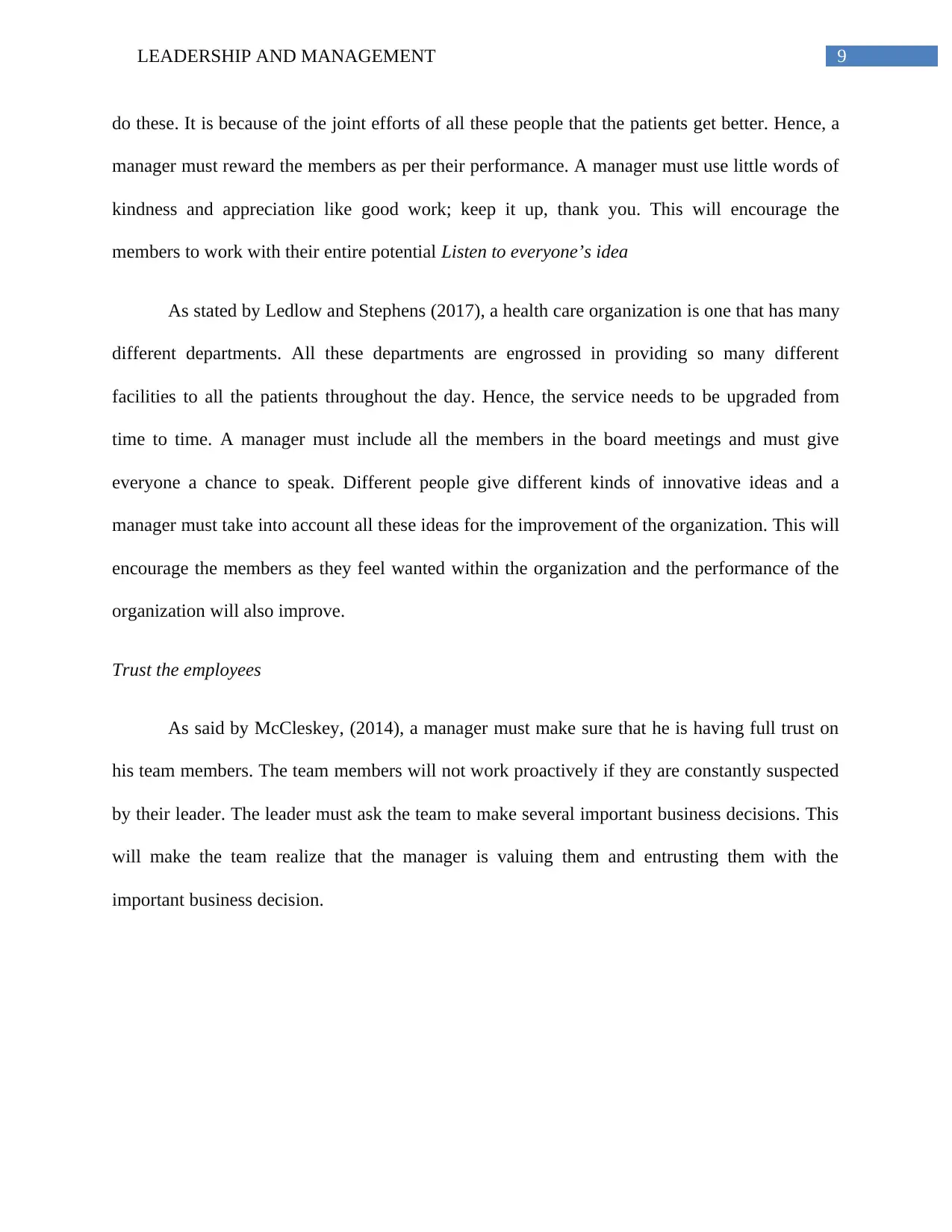
9LEADERSHIP AND MANAGEMENT
do these. It is because of the joint efforts of all these people that the patients get better. Hence, a
manager must reward the members as per their performance. A manager must use little words of
kindness and appreciation like good work; keep it up, thank you. This will encourage the
members to work with their entire potential Listen to everyone’s idea
As stated by Ledlow and Stephens (2017), a health care organization is one that has many
different departments. All these departments are engrossed in providing so many different
facilities to all the patients throughout the day. Hence, the service needs to be upgraded from
time to time. A manager must include all the members in the board meetings and must give
everyone a chance to speak. Different people give different kinds of innovative ideas and a
manager must take into account all these ideas for the improvement of the organization. This will
encourage the members as they feel wanted within the organization and the performance of the
organization will also improve.
Trust the employees
As said by McCleskey, (2014), a manager must make sure that he is having full trust on
his team members. The team members will not work proactively if they are constantly suspected
by their leader. The leader must ask the team to make several important business decisions. This
will make the team realize that the manager is valuing them and entrusting them with the
important business decision.
do these. It is because of the joint efforts of all these people that the patients get better. Hence, a
manager must reward the members as per their performance. A manager must use little words of
kindness and appreciation like good work; keep it up, thank you. This will encourage the
members to work with their entire potential Listen to everyone’s idea
As stated by Ledlow and Stephens (2017), a health care organization is one that has many
different departments. All these departments are engrossed in providing so many different
facilities to all the patients throughout the day. Hence, the service needs to be upgraded from
time to time. A manager must include all the members in the board meetings and must give
everyone a chance to speak. Different people give different kinds of innovative ideas and a
manager must take into account all these ideas for the improvement of the organization. This will
encourage the members as they feel wanted within the organization and the performance of the
organization will also improve.
Trust the employees
As said by McCleskey, (2014), a manager must make sure that he is having full trust on
his team members. The team members will not work proactively if they are constantly suspected
by their leader. The leader must ask the team to make several important business decisions. This
will make the team realize that the manager is valuing them and entrusting them with the
important business decision.
⊘ This is a preview!⊘
Do you want full access?
Subscribe today to unlock all pages.

Trusted by 1+ million students worldwide
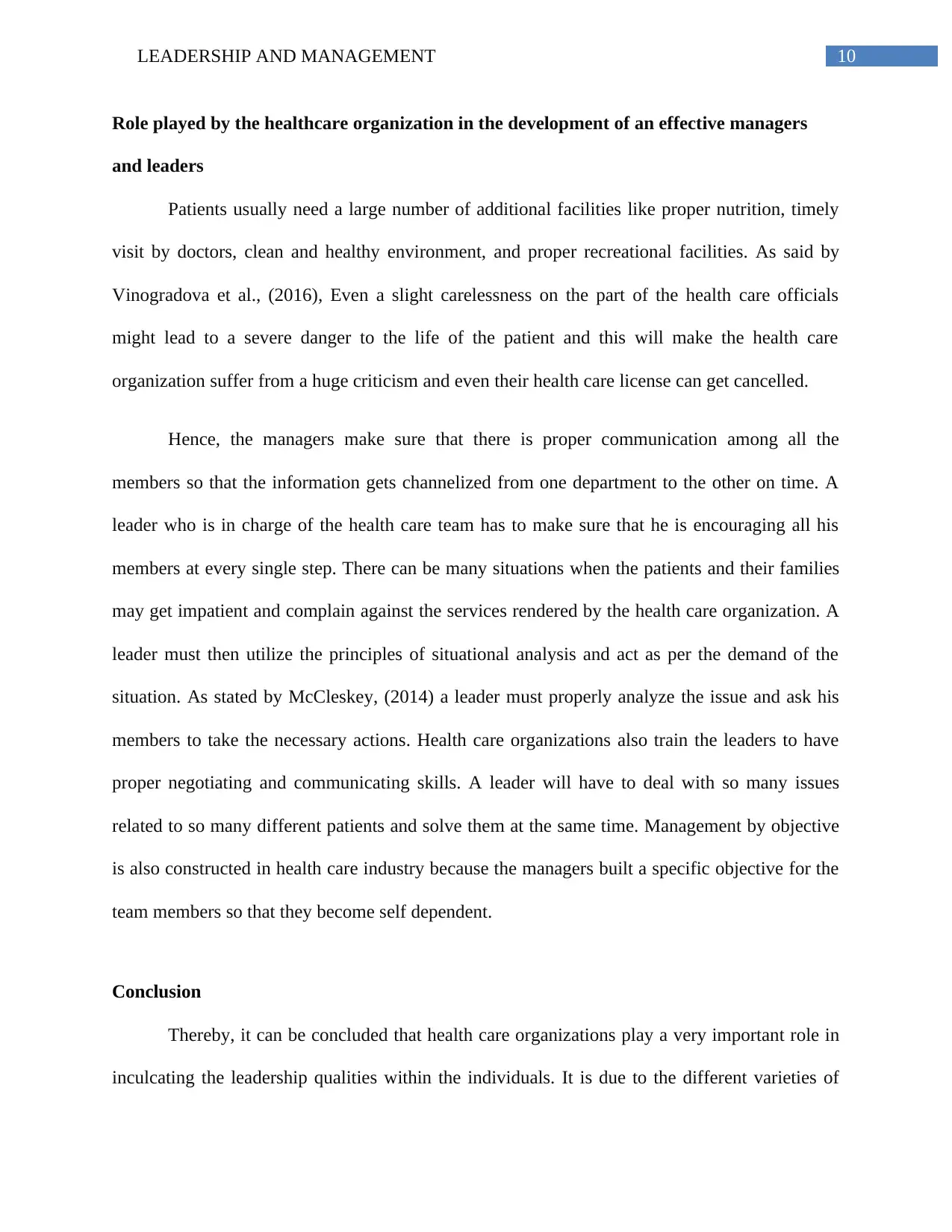
10LEADERSHIP AND MANAGEMENT
Role played by the healthcare organization in the development of an effective managers
and leaders
Patients usually need a large number of additional facilities like proper nutrition, timely
visit by doctors, clean and healthy environment, and proper recreational facilities. As said by
Vinogradova et al., (2016), Even a slight carelessness on the part of the health care officials
might lead to a severe danger to the life of the patient and this will make the health care
organization suffer from a huge criticism and even their health care license can get cancelled.
Hence, the managers make sure that there is proper communication among all the
members so that the information gets channelized from one department to the other on time. A
leader who is in charge of the health care team has to make sure that he is encouraging all his
members at every single step. There can be many situations when the patients and their families
may get impatient and complain against the services rendered by the health care organization. A
leader must then utilize the principles of situational analysis and act as per the demand of the
situation. As stated by McCleskey, (2014) a leader must properly analyze the issue and ask his
members to take the necessary actions. Health care organizations also train the leaders to have
proper negotiating and communicating skills. A leader will have to deal with so many issues
related to so many different patients and solve them at the same time. Management by objective
is also constructed in health care industry because the managers built a specific objective for the
team members so that they become self dependent.
Conclusion
Thereby, it can be concluded that health care organizations play a very important role in
inculcating the leadership qualities within the individuals. It is due to the different varieties of
Role played by the healthcare organization in the development of an effective managers
and leaders
Patients usually need a large number of additional facilities like proper nutrition, timely
visit by doctors, clean and healthy environment, and proper recreational facilities. As said by
Vinogradova et al., (2016), Even a slight carelessness on the part of the health care officials
might lead to a severe danger to the life of the patient and this will make the health care
organization suffer from a huge criticism and even their health care license can get cancelled.
Hence, the managers make sure that there is proper communication among all the
members so that the information gets channelized from one department to the other on time. A
leader who is in charge of the health care team has to make sure that he is encouraging all his
members at every single step. There can be many situations when the patients and their families
may get impatient and complain against the services rendered by the health care organization. A
leader must then utilize the principles of situational analysis and act as per the demand of the
situation. As stated by McCleskey, (2014) a leader must properly analyze the issue and ask his
members to take the necessary actions. Health care organizations also train the leaders to have
proper negotiating and communicating skills. A leader will have to deal with so many issues
related to so many different patients and solve them at the same time. Management by objective
is also constructed in health care industry because the managers built a specific objective for the
team members so that they become self dependent.
Conclusion
Thereby, it can be concluded that health care organizations play a very important role in
inculcating the leadership qualities within the individuals. It is due to the different varieties of
Paraphrase This Document
Need a fresh take? Get an instant paraphrase of this document with our AI Paraphraser
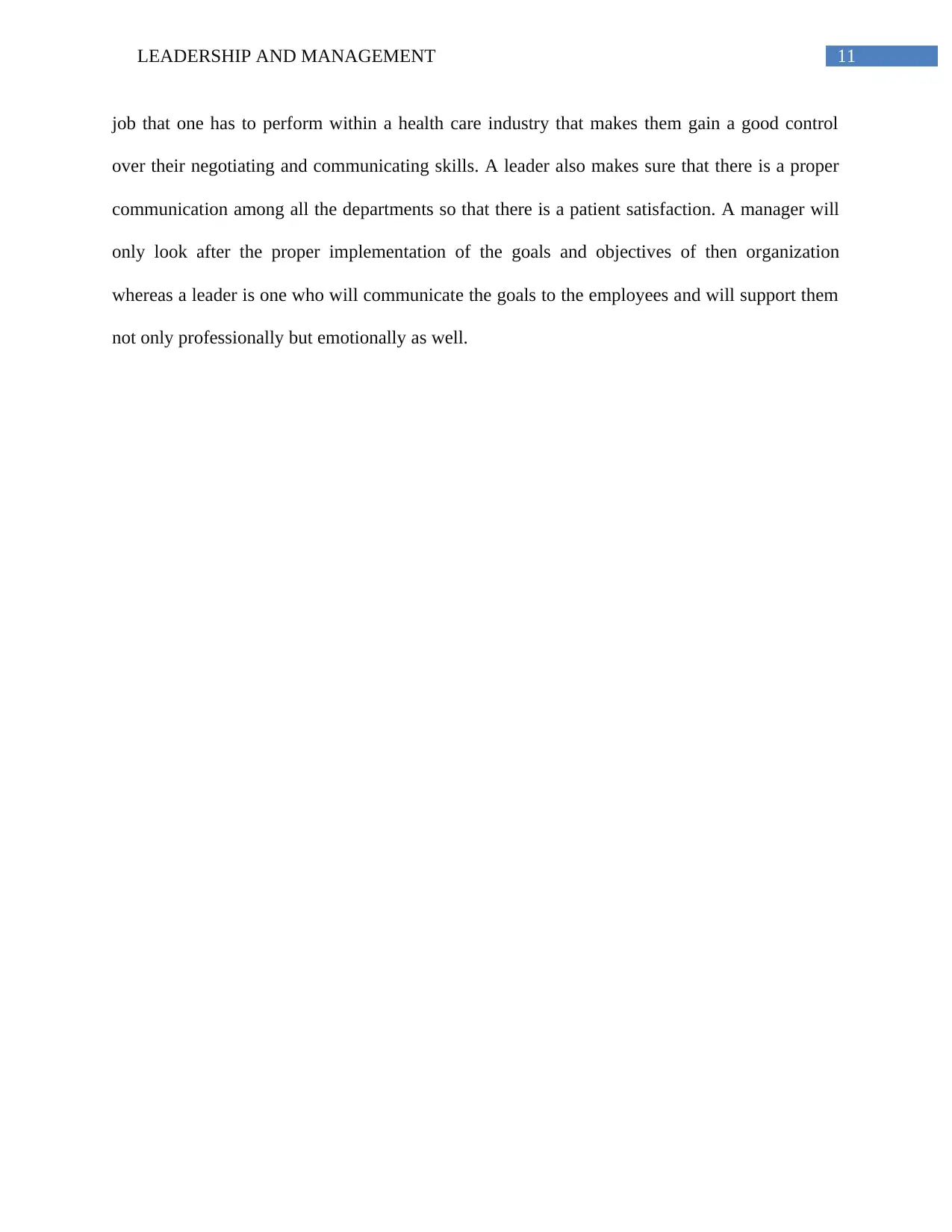
11LEADERSHIP AND MANAGEMENT
job that one has to perform within a health care industry that makes them gain a good control
over their negotiating and communicating skills. A leader also makes sure that there is a proper
communication among all the departments so that there is a patient satisfaction. A manager will
only look after the proper implementation of the goals and objectives of then organization
whereas a leader is one who will communicate the goals to the employees and will support them
not only professionally but emotionally as well.
job that one has to perform within a health care industry that makes them gain a good control
over their negotiating and communicating skills. A leader also makes sure that there is a proper
communication among all the departments so that there is a patient satisfaction. A manager will
only look after the proper implementation of the goals and objectives of then organization
whereas a leader is one who will communicate the goals to the employees and will support them
not only professionally but emotionally as well.
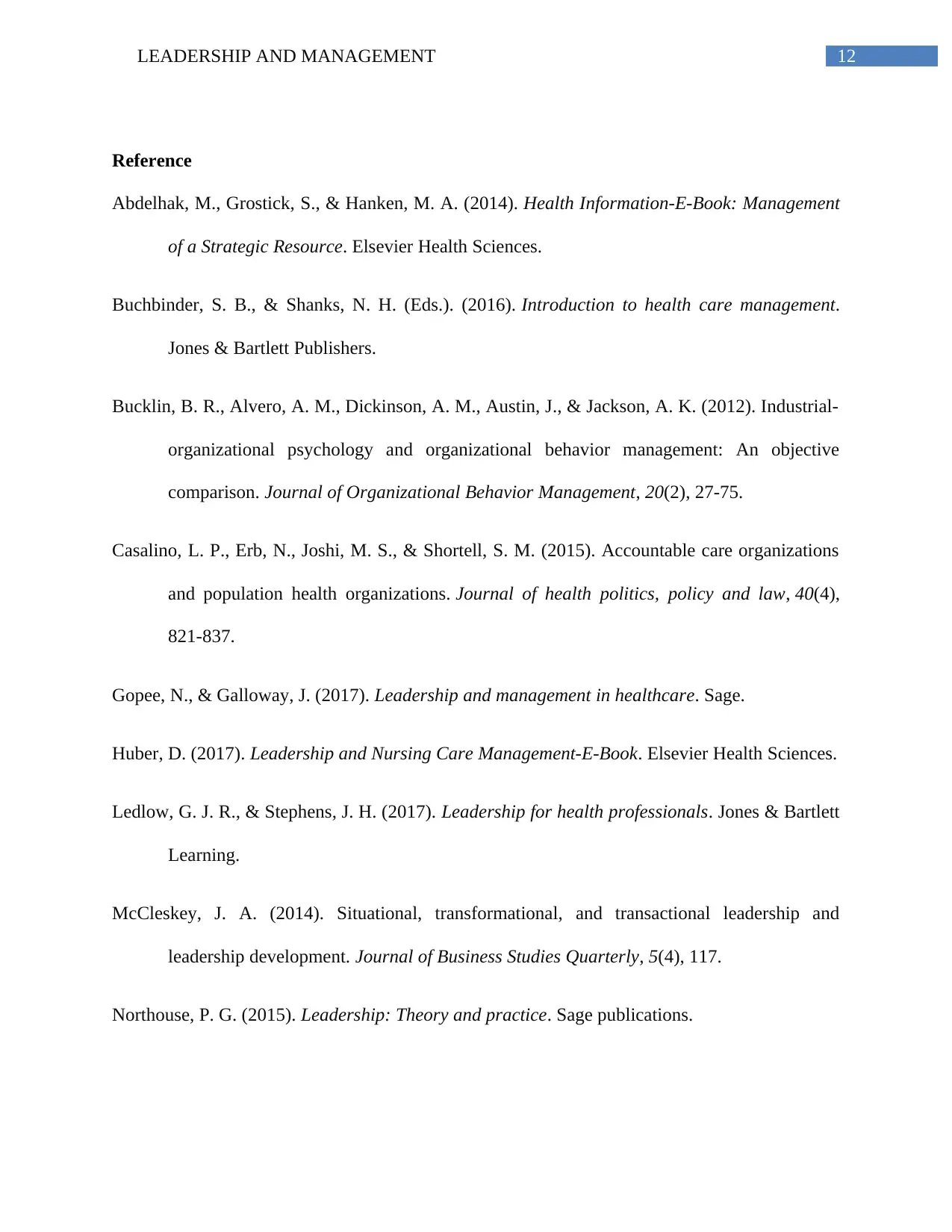
12LEADERSHIP AND MANAGEMENT
Reference
Abdelhak, M., Grostick, S., & Hanken, M. A. (2014). Health Information-E-Book: Management
of a Strategic Resource. Elsevier Health Sciences.
Buchbinder, S. B., & Shanks, N. H. (Eds.). (2016). Introduction to health care management.
Jones & Bartlett Publishers.
Bucklin, B. R., Alvero, A. M., Dickinson, A. M., Austin, J., & Jackson, A. K. (2012). Industrial-
organizational psychology and organizational behavior management: An objective
comparison. Journal of Organizational Behavior Management, 20(2), 27-75.
Casalino, L. P., Erb, N., Joshi, M. S., & Shortell, S. M. (2015). Accountable care organizations
and population health organizations. Journal of health politics, policy and law, 40(4),
821-837.
Gopee, N., & Galloway, J. (2017). Leadership and management in healthcare. Sage.
Huber, D. (2017). Leadership and Nursing Care Management-E-Book. Elsevier Health Sciences.
Ledlow, G. J. R., & Stephens, J. H. (2017). Leadership for health professionals. Jones & Bartlett
Learning.
McCleskey, J. A. (2014). Situational, transformational, and transactional leadership and
leadership development. Journal of Business Studies Quarterly, 5(4), 117.
Northouse, P. G. (2015). Leadership: Theory and practice. Sage publications.
Reference
Abdelhak, M., Grostick, S., & Hanken, M. A. (2014). Health Information-E-Book: Management
of a Strategic Resource. Elsevier Health Sciences.
Buchbinder, S. B., & Shanks, N. H. (Eds.). (2016). Introduction to health care management.
Jones & Bartlett Publishers.
Bucklin, B. R., Alvero, A. M., Dickinson, A. M., Austin, J., & Jackson, A. K. (2012). Industrial-
organizational psychology and organizational behavior management: An objective
comparison. Journal of Organizational Behavior Management, 20(2), 27-75.
Casalino, L. P., Erb, N., Joshi, M. S., & Shortell, S. M. (2015). Accountable care organizations
and population health organizations. Journal of health politics, policy and law, 40(4),
821-837.
Gopee, N., & Galloway, J. (2017). Leadership and management in healthcare. Sage.
Huber, D. (2017). Leadership and Nursing Care Management-E-Book. Elsevier Health Sciences.
Ledlow, G. J. R., & Stephens, J. H. (2017). Leadership for health professionals. Jones & Bartlett
Learning.
McCleskey, J. A. (2014). Situational, transformational, and transactional leadership and
leadership development. Journal of Business Studies Quarterly, 5(4), 117.
Northouse, P. G. (2015). Leadership: Theory and practice. Sage publications.
⊘ This is a preview!⊘
Do you want full access?
Subscribe today to unlock all pages.

Trusted by 1+ million students worldwide
1 out of 14
Related Documents
Your All-in-One AI-Powered Toolkit for Academic Success.
+13062052269
info@desklib.com
Available 24*7 on WhatsApp / Email
![[object Object]](/_next/static/media/star-bottom.7253800d.svg)
Unlock your academic potential
Copyright © 2020–2025 A2Z Services. All Rights Reserved. Developed and managed by ZUCOL.




